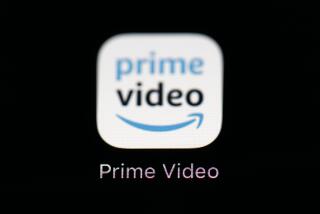Ailing MGM May Need Life Support From Big Studios
MGM is giving new meaning to the term deja vu.
For more than a decade now, Hollywoodâs once-golden movie studio has been on life support as it follows a vicious economic cycle. Today the studio, once again cash-strapped and desperate, is gasping for air.
Even if majority shareholder Kirk Kerkorian pours in another $450 million to help fund new production as part of a proposed increase in a company rights offering, it is strictly a temporary fix.
Thereâs talk in Hollywoodâs creative and business circles that MGM chief Frank Mancuso, who took over the studio in 1993, may be in trouble.
Itâs safe to say that the legendary studio hasnât been the same since Kerkorian, in his role as owner, sold the entire MGM library--with such classics as âGone With the Windâ and âThe Wizard of Ozâ as well as more recent titles--to Ted Turner in 1986.
Given the high-risk, low-return economics and the volatility of the movie business today, itâs virtually impossible to be a stand-alone studio trying to compete with the Hollywood majors without the cash flow and diversification--not to mention leverage--to weather the bad times.
The last two years have been particularly bad for MGM because of a paucity of box-office hits. Other than its latest James Bond sequel, âTomorrow Never Dies,â which has grossed $337 million worldwide, and âThe Man in the Iron Mask,â which to date has taken in close to $150 million globally, MGM has had a string of flops, including âRed Corner,â âHoodlum,â âTurbulenceâ and âDisturbing Behavior.â âSpecies 2â and âDirty Workâ combined for a write-down of about $33 million.
During an 18-month production shutdown, starting when Credit Lyonnais bank announced in early 1996 that the studio would be sold, MGMâs release schedule was littered with dismally performing films from its acquisitions of Orion Pictures and Samuel Goldwyn Co.
MGM has only two releases scheduled for the remainder of this year: âRonin,â starring Robert DeNiro (Oct. 2), and âAt First Sight,â with Val Kilmer and Mira Sorvino (Nov. 20). Half a dozen are expected in the first quarter of 1999.
The next Bond installment, temporarily referred to as âBond 19,â is planned for a November 1999 release. Production will get underway in January, with Michael Apted directing and Pierce Brosnan starring.
The difference between MGM and companies like Disney, Warner Bros. and 20th Century Fox, which also have had their share of rotten times at the box office, is that those studios have other major businesses--such as theme parks, record companies, cable channels and television networks--to cushion movie losses.
Thatâs why MGM is now engaged in exploratory talks with such vertically integrated media companies as Disney, Warner and Fox--to see if it can structure a deal that will give it both a cash infusion and access to their global distribution outlets.
For the majors, the attraction is simple. They want control of MGMâs 4,000-title modern library and have no interest in maintaining the company as an ongoing concern for movie and TV production.
For Disney, the depth of MGMâs modern catalog is particularly enticing since its own post-1948 live-action library has a surprisingly modest number of titles: 336 compared with Warnerâs 1,935, Sony Picturesâ 1,422, Foxâs 1,096, Universalâs 1,076 and Paramountâs 902.
As one executive put it, âitâs the one gap in the companyâs arsenal that it doesnât have significant inventory of non-Disney films.â Historically, Disney has been short on titles because for a long time its mainstay was TV product, nature documentaries and animated features. Not until the Michael Eisner-Jeffrey Katzenberg regime took hold in the 1980s did the studio begin churning out live-action movies on a regular basis.
*
Having thousands of titles from the MGM library (which includes movies from its United Artists label plus those from Orion Pictures and Goldwyn) would boost overseas TV sales for Disney as well as feed its ABC network and home video unit with movies that include the Bond, âPink Pantherâ and âRockyâ franchises.
However, in trying to structure a deal, MGM is haunted by a recurring nightmare going back to the days of former owner Giancarlo Parretti. When he bought MGM in November 1990, he leveraged the library by licensing the video rights to Warner and cable rights to Turner.
They were bad deals for MGM. Warner put up $125 million for video rights that extended 13 years. Turner, now Time Warnerâs largest shareholder, ponied up $225 million for cable rights for the same 13 years to the pre-1986 MGM library, which not only includes several classic MGM titles but Warner Bros. classics as well. Some of those cable rights start reverting back to MGM between 2000 and 2003.
The video rights are the most problematic because of how lucrative they are; Warner made its $125-million investment back in the first 18 months of its arrangement. Factored over 13 years, that would be more than $1 billion--roughly what Kerkorian and his partners paid for the entire company in 1996.
Warnerâs rights donât expire until 2003, so Disney or any other buyer wonât have access to them for five years. But thereâs an even more troubling issue. While the terms might be disputed, Warner may be entitled to the home video rights of any acquiring company. Because Warner holds such a trump card, Disney and other potential buyers of MGMâs library are talking to the Burbank-based studio about structuring a joint deal.
The onerous clause in Warner Bros.â contract is largely responsible for scaring off every major studio from buying MGM.
Enter Kerkorian, who bought the studio for the third time in 29 years, along with partner Seven Network of Australia. Kerkorian first bought MGM in 1969, adding United Artists in 1981. He sold MGM/UA Communications to Turner in 1986 for $1.5 billion, but months later, when Turner realized he couldnât afford the deal, he sold most of the assets, including the valuable MGM logo and the UA library, back to Kerkorian, keeping the 3,000-title MGM catalog.
This round, Kerkorianâs personal investment to date is just over $1.5 billion, if you include the $450 million heâs expected to spend to cover MGMâs increased $500-million rights offering.
Kerkorian wants to get his money out of MGM, but other entertainment companies donât seem likely to offer that much. Sources close to Kerkorian said he would consider a partial stock offer instead of all cash to clinch a deal.
In a filing with the Securities and Exchange Commission two weeks ago, MGM divulged that it had only $132 million remaining in its $1.3-billion credit facility and that its cash crunch would force cutbacks and a freeze on all new development for television.
While Kerkorianâs money would help pay down debt and, some suggest, may even lift the freeze on TV--one of MGMâs best-performing divisions--industry analysts suggest that the Las Vegas billionaireâs latest gesture and even a strategic alliance with a studio would be little more than temporary solutions.
âItâs never going to be enough until MGM starts to succeed in an unprecedented way or work under a different financial model like New Line used to do when it made movies for a price,â said one observer.
âUnless they partner with someone over the long term . . . theyâll have to keep mortgaging their library to stay alive.â
*
Eller is a Times staff writer. Brennan is a frequent contributor to The Times. Exhibitor Relations provided statistical information for this report.
More to Read
The biggest entertainment stories
Get our big stories about Hollywood, film, television, music, arts, culture and more right in your inbox as soon as they publish.
You may occasionally receive promotional content from the Los Angeles Times.










